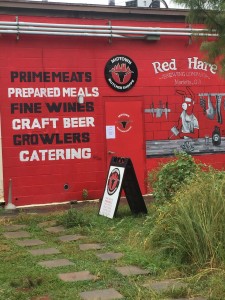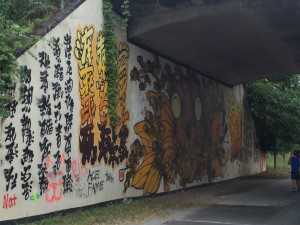A plethora of stores have fronts or backs along the Beltline, and, like the Beltline itself, they take advantage of art to mix practicality and aesthetic, in this situation for advertisement. The Midtown Butcher Shoppe, pictured above, is one of these. The back of the store, lined along the walking path, features a red hare, representing the brewing company, preparing to cut up meat. On the left side, the store has painted a mini-menu of stand-out words that advertise what the store offers: Prime meats, prepared meals, fine wines, craft beers, growlers, and catering. Also like many stores, they have put a door in the middle of the back for easy Beltline access.
Bee Mural
Underneath a bridge, two parallel walls each feature a mural. The above picture features one of them. In the center, an enormous black and dark yellow bee emerges from a similarly sized and colored flower. Several smaller bees, also the same black and yellow, spiral out from the center, surrounding the largest bee and flower. Chinese letters flank the bees on either side. Closest to the bees, the letters are bigger and change along a spectrum vertically: the highest row is a very bright yellow, nearly white, followed by two rows a standard yellow then darker yellow below, and ended with a shade that resembles a dark red. Outside of these letters are smaller and scattered black letters. On the leftward side out of the picture’s range, the artist has signed his or her name.
Skater Sculpture on the Beltine
Quickly after entering the Beltline, I found my first piece of art (and would later be stunned by the quantity present): a sculpture, in the image above. In short, the sculpture shows a skateboarder, standing several feet taller than the people passing by. Both the skateboard and skateboarder are constructed out of typical piping, red for the rider and blue for the board, with skateboard wheels that look like little car tires.
Built Environment Description Question
What types of skills, techniques, and strategies will we be learning and using for observing and analyzing the environment?
Annotated Bibliography Draft
First Draft of Bibliography Annotation
Reflection on Initial Experiences with Atlanta and the Built Environment
I must admit that, when I began this course, I found the concept of an entire class, a language arts class at that, about something called the built environment a peculiar course to start college; however, the cluster classes working together to emphasize the artificial geography where and how we live has quickly made me much more interested in the subject. Although I have always loved history, my preference for words over pictures led my self-education to be driven away from hands-on work and instead remain insulated with books. Through both the articles and books that I have read and the walking that I have done in Atlanta both in class and personally has demonstrated to me both the importance and potential of using archaeology and the built environment to understand the past and find greater insight into history. We can best learn through the combination of various sources such as written and architectural instead of focusing solely on one. Especially now that I know about sources like the archives, I am excited to begin incorporating visuals into my written and investigating and learning about architecture and using it in historical analysis. Further, as I was reading Where We Want to Live last night for our seminar, I saw extremely vividly how the built environment plays a huge role that I want to be a part of in my future. I want to work on improving and building living conditions in both the United States and developing countries, and this book helped open my mind to how the structure and transportation patterns influence, even determine, the ways that people live and build cities. Beginning this class, I was neither excited nor interested in the subject matter nor the work that we will have to do, but that has quickly been reversed. I am learning so much now in class and even out of class through reading and listening to podcasts. There is a lot that the built environment of Atlanta, and anywhere really, can teach me about how to live every day, to improve the work that I want to be part of, to increase my awareness and appreciation of my surroundings, and to be more versatile and adaptable in the modes that I can learn and teach with.
Bibliography for Reading Annotations 1 Using Zotero
Syllabus Quiz
Questions:
What are the major projects? In a bulleted list, provide links to the project descriptions for each of them.
- Reading Annotations
- Annotated Bibliography
- Built Environment Descriptions
- Built Environment Analysis
How will your final grade be calculated?
Points are earned through assignments, projects, and extra credit. Points are gained rather than lost.
What is the “submission form” and how do you use it? Embed the form below your answer (hint: Google “embed Google form” to find out how).
The submission form is the area of the website where we can submit all digital assignments. It can be used by going to the website and choosing submission form under the projects tab.
Embed the course calendar and weekly overview below this question.
Where on the course website can you find an overview of what’s due and the readings for each unit?
Select Unit Overview under the Calendar tab
What is the best way to see an overview of what’s due each week?
Select Weekly Overview under the Calendar tab
What is the attendance policy?
Students earn ten points for attending class and lose ten points for unexcused absences.
What are the two ways you can lose points?
Unexcused absences and not submitting class preparation assignments.
What are my office hours, and how do you make an appointment to see me outside of class?
Office hours are from 9-11 on Tuesdays and Thursdays, and email, Skype, or Google Hangouts can be used to schedule and facilitate appointments.
How do you earn participation credit? Provide a link to the instructions/guidelines for participation.
Participation points can be earned by attending class, participating in class, and completing assignments on time, plus other options that include using of technology and other optional activities.
How many points can you earn by participating in or organizing a study group session?
Up to 25
How can you be assured of earning an “A” in this course?
Complete all major projects, miss no more than four classes, and earning 2,800 points.
What are the minimum requirements for earning a passing grade of “C”?
Missing only four classes, completing major projects, and earning 1,675 points.
What do you do if you’re not sure how to document your participation in order to earn points?
Ask Dr. Wharton during office hours or before or after class.
What are the Unit 1 readings and which one would you like to annotate for Reading Annotation 1?
Thomas Carter and Elizabeth Collins Cromley, “Introduction,” from Invitation to Vernacular Architecture
James Deetz, “Parting Ways,” from In Small Things Forgotten: An Archaeology of Early American Life
Stephanie Fitzgerald, “The Cultural Work of a Mohegan Painted Basket,” from Early Native Literacies in New England: A Documentary and Critical Anthology


